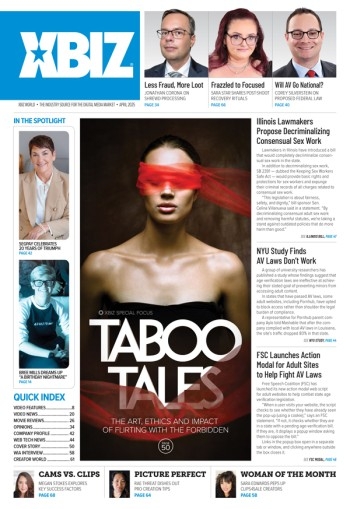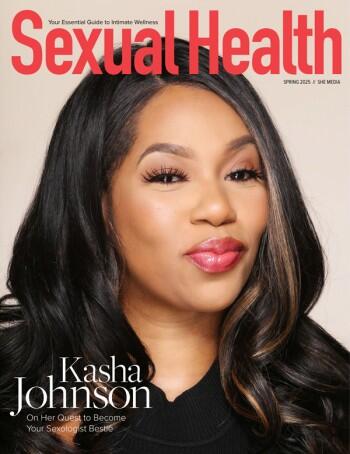2025 is upon us, and the pleasure industry is poised for another dynamic year. As brands realign their goals to satisfy shifting demand, seize new opportunities and capitalize on cutting-edge innovations, the focus for the new year is on delivering inclusive, accessible and technology-driven products that redefine pleasure and wellness.
Toys with app connectivity, long-distance remote control and interactivity with adult content are becoming increasingly common. Stimulating functions beyond vibration continue to attract attention, offering unique, realistic movements and sensations. Brands like Kiiroo, Svakom and Satisfyer are aiming to bring interactive toys to the forefront of the pleasure market, and some anticipate AI-powered sextech in the near future. Meanwhile, the unpredictable economy has sparked a growing focus on affordable products, as pleasure manufacturers balance quality with cost to meet the needs of price-conscious shoppers in 2025. Furthermore, acquisitions, partnerships and collaborations are emerging as vital strategies for growth, with companies tapping into each other’s customer base to expand their reach.
From new products to evolving strategies for marketing to both seasoned and first-time shoppers, 2025 is set to be another exciting year full of changes.
As always, customer engagement remains a major focus, since fostering stronger connections is key to success in adult retail — whether via social media or through personalized service and educational initiatives for B2C and B2B audiences. That’s why pleasure brands, retailers and wholesalers gear up months in advance to launch marketing campaigns for upcoming releases, conduct client visits and trainings, and attend annual trade shows.
From new products to evolving strategies for marketing to both seasoned and first-time shoppers, 2025 is set to be another exciting year full of changes — and helping to kick it off will be XBIZ Expo, offering an in-person preview of trends to look forward to. In this report, we ask participating vendors about their predictions.
Sexual Wellness: The New Normal
In recent years, societal attitudes regarding sex, sexuality and pleasure have been changing. Though not completely eradicated, stigma surrounding sex has decreased significantly. That’s good news for the pleasure industry.
“More people now see sexual wellness as a vital part of overall well-being,” says Lucy Robinson, head of marketing and communications at Creative Conceptions. “Sex is becoming increasingly mainstream worldwide, unlocking significant potential for our industry.”
Not too long ago, the only pleasure products stocked by pharmacies and big-box stores like Walmart were condoms and a few lubricants. Now, those stores carry C-rings and vibrators.
Sven Pelka, CEO of Triple A, views this as an overall plus.
“We hope to see greater acceptance of pleasure products in mainstream retail, helping to destigmatize the category and increase access to sexual wellness worldwide,” he says.
Though opinions about this development vary in both mainstream and adult channels, it is nevertheless indicative of society’s changing views regarding sex in general and pleasure products specifically.
“I think there is a notable shift toward more open and inclusive conversations about pleasure and intimacy,” comments Weronika Szczesna, Svakom’s global marketing and PR manager. She credits the dedicated members of the pleasure industry with helping to bring about the shift.
“They have worked to dismantle taboos and champion body positivity and self-acceptance,” she affirms.
Szczesna hopes that the coming year will see continued normalization of talking about sexual wellness and pleasure, and that we can eventually live “in a world where individuals feel empowered to explore their desires with confidence, free of stigma or judgment, and where sexual wellness becomes a natural and valued part of overall well-being.”
The increasing focus on the health and wellness aspects of sex can be attributed to the explosive rise of social media and widespread availability of resources available to consumers, as well as the influence of Gen Z.
Unlike previous generations, Gen Z has always lived in a connected world; Gen Zers’ facility with social media and tech is part and parcel of who they are. They are also known for their strong views on social issues like diversity and inclusiveness, and not just accepting information at face value. With an estimated 2 billion Gen Zers — around 32% of the world’s population — their impact on the pleasure industry and society in general has been nothing short of profound.
How will all of this impact the pleasure sector in the year ahead? Pelka sees the shift in attitude happening across a wider demographic than just Gen Z.
“There has been a movement in acceptance and destigmatization of sex toys, with customers viewing them as tools or aids for enhancing sexual wellness and intimacy,” Pelka observes. “The industry has therefore been moving beyond traditional sex toys, embracing a broader focus on health, wellness and inclusivity.”
Ian Kulp, director of marketing at Blush, expects that this shift in focus will translate into increased demand for educational tools and products that are accessible and approachable but still premium quality.
“In 2024, inclusivity, wellness and sustainability reshaped the sexual wellness landscape, redefining what consumers expect from brands,” Kulp says. “In 2025, we anticipate these trends will deepen, with an even greater emphasis on personal empowerment and hybrid solutions that blend wellness and pleasure.”
Technology and Sustainability
Two notable trends with momentum carrying over into 2025 are the popularity of high-tech, app-enabled devices, and continued demand for sustainable and eco-friendly products.
Mike Sullivan, CFO of Bad Dragon, notes the impact of advances in sextech on customers and the industry.
“We’ve seen further development of app-controlled devices, AI-powered products and teledildonics, which have led to more enjoyable user experiences and safer play, and helped enhance long-distance relationships,” he observes.
Robin Lee of Lovement anticipates that app-controlled toys will remain popular in the coming year.
“2024 saw the growing popularity of app-controlled toys,” Lee notes. “I believe developing proprietary platforms and integrating them with products will become a significant trend.”
In addition to facilitating long-distance play, app-controlled devices offer a level of customization that proved popular in 2024. Pelka predicts that these products will only grow more popular in the coming year, especially as technology continues to improve.
“In 2025, we expect a further shift toward personalization, with advancements in AI and customizable products driving this change,” he says.
Shoppers have shown themselves to be ecologically conscious as well. Pleasure products are now available in biodegradable materials, packaging has been streamlined and uses less plastic, and companies are increasingly developing new products with sustainability in mind.
“The push for sustainability will continue to amplify in 2025, with consumers increasingly expecting eco-friendly solutions across all industries, including sexual wellness,” says Love Not War founder Will Ranscombe. “The modularity trend will also grow, as more brands explore ways to extend product life cycles and reduce waste.”
Price-Conscious Pleasure
In an uncertain economy, manufacturers must also balance affordability with functionality. Nalpac’s Director of Marketing and Strategic Partnership Phoebe Grott expects shoppers to continue to be price-conscious in 2025.
“To be successful, retailers should be savvy in pricing and curate offerings that include upsell and add-ons to low-to-mid-range price-point purchases,” she advises. “There will be an expectation that good quality and experience be paired with affordability.”
The flip side: While sales have declined over the past two years, necessity has also proved the mother of invention.
“Economic pressures have encouraged brands and retailers to innovate more strategically, finding the delicate balance between affordability and quality without sacrificing the features consumers demand,” says Blush’s Kulp.
According to Vincent Renou, global sales director at Honey Play Box, achieving that balance is his company’s biggest goal in 2025.
“Our main focus will be creating new, exciting products that make a real difference in people’s lives — while keeping them accessible to everyone,” he shares. “With economic uncertainty affecting much of the world, we believe it’s more important than ever to stay committed to what we do best: innovating in the sexual wellness industry.”
Betty’s Toy Box founder and CEO Carolyn Eagle also has concerns about how doings in the wider world could impact business.
“What 2025 holds is anybody’s guess right now,” she says. “As an e-tailer with stores in Canada and the U.S., I think we are all waiting to see how new policies and tariffs may affect our industry.”
Adapt, Educate, Cooperate
Until any new policies are implemented, industry professionals remain focused on things they can influence and strategies they can implement now.
For Bonnie Feingold, CEO and president of distributor Honey’s Place, adaptability is a key factor in determining whether a business fails or thrives.
“With the industry in flux, some stores are successfully aligning their product offerings to meet customer needs and wants, while others struggle to adapt,” says Feingold. “Success for manufacturers, distributors and retailers depends on carrying the right products that resonate with their clientele. In the coming year, businesses must prioritize quality, value and relevance to remain competitive and better serve their customers.”
For Robinson and Creative Conceptions, adaptability means agility. Since trends and channel popularity can change quickly, she says, companies must avoid getting locked into a rigid plan.
“Reactive marketing is essential for staying relevant and gaining brand awareness,” she says.
Ranscombe says Love Not War also prioritizes adaptability, as trends and market needs can shift.
“Collaboration with retail partners and ongoing market research help ensure we stay ahead of the curve,” he adds.
Ranscombe also notes another priority many in the pleasure industry share: educating both business partners and the general public.
“There’s still room for improvement in education and destigmatization,” he says. “In 2025, I hope to see more collaboration between brands, retailers and educators to break taboos and create safe spaces for dialogue.”
To that end, brands like Blush and distributors like Williams Trading Co. and Eldorado offer their retailers comprehensive educational modules that cover a wide variety of topics.
“We continue to prioritize educational initiatives like Blush U, fostering deeper connections and equipping partners with resources that help them engage consumers meaningfully,” offers Kulp.
Eagle ranks education right up there with affordability, when it comes to meeting retail shoppers’ needs in 2025.
“Our customers want and need these two things and trust us to provide them,” she points out.
In the face of unpredictable new challenges, some identify unity and collaboration as productive approaches.
While working with distributors seems to have fallen out of favor with some manufacturers and retailers in recent years, Feingold points out potential benefits.
“Partnering with a distributor offers businesses flexibility, allowing them to purchase small quantities with no minimum order requirements, ensuring efficient inventory management,” she explains. “Distributors support businesses by providing a diverse product selection and adaptable solutions to help them succeed in any economic climate.”
Robinson agrees, revealing that one of Creative Conceptions’ goals for 2025 is strengthening partnerships.
“We’re prioritizing closer collaboration with distributors to enhance support and streamline sales channels for maximum efficiency,” she says.
Getting Out in Front of the Future
Even though pleasure brands are limited in the degree to which they can anticipate emerging trends, they must still prepare their product lines well in advance. The same goes for retailers planning their merchandising strategies.
According to Szczesna, Svakom might prepare for a campaign or event anywhere from three months to a year in advance, depending on scale and complexity. Kulp says Blush starts planning for the following year as early as the second quarter, so that by Q4 the company is refining strategies to make sure every element, from campaign messaging to event logistics, is aligned and ready for seamless execution come January.
Bad Dragon takes time in the months preceding a new year to prepare by analyzing sales metrics, market trends and customer feedback.
“This helps us identify our strengths in product lines and customization features, as well as areas where we can improve or innovate,” Sullivan shares. “From there, we set clear and measurable goals and objectives to further enhance and improve our customer experience. This long-term planning process ensures that we can integrate feedback from previous events and campaigns and continuously improve our approach.”
Honey Play Box has already mapped out its plans for the next 10 months.
“Our marketing plans are built around launches and events, so everything flows naturally,” Renou says, though he adds that the company builds in some flexibility to allow for brainstorming new innovations.
“It’s a balance of having a clear plan and staying open to new possibilities,” he explains. “Moments of creativity and collaboration are some of the most exciting parts of our process.”
Of course, a key element in nearly every company’s planning process is trade show attendance.
Intimate Distribution/INTY Toys founder Tim Faber looks toward the new year with plans for bolstering the company’s global presence by attending XBIZ Expo and events in Barcelona and Amsterdam.
“We also hope to attend the May XBIZ Retreat in Miami,” he says. “These events are crucial to maintaining INTY’s strong position and further expanding our reach.”
After making one of its first trade show appearances at last January’s Vibe Expo, industry newcomer Top Drawer Toys is returning to XBIZ Expo with its latest addition, the G-Rocker.
“It has all of the same outstanding features of the Box Rocker, but it is engineered to stimulate the G-Spot rather than offer a thrusting sensation,” shares Top Drawer project manager Lauren Head.
According to Head, the company is applying what it learned at last year’s event and plans to “hit the ground running in 2025” at January’s XBIZ Expo.
Industry trade shows offer specific benefits for retailers, notes Carolyn Eagle of Betty’s Toy Box.
“It’s always the best way to know which new products are coming and see items in person to decide what we will carry,” Eagle highlights. “Trade shows are also a great way to get a feel for what is going on in the industry, particularly with upcoming trends.”
Although Betty’s Toy Box can’t prepare in advance for new products that brands keep under wraps until their big debut, Eagle says the company does prepare marketing campaigns as far ahead as possible by staying informed about upcoming releases.
For manufacturers such as Dingfoo, planning can even happen years in advance. The company plans to showcase over 100 new products at 12 global trade shows in 2025, and company owner Liu Quiming says he has a three-and-a-half-year reserve in place for these planned tech unveilings.
Expanding Horizons
As the industry gears up for 2025, leading brands are setting ambitious goals that blend innovation, accessibility and connection with their diverse customers. From expanding product lines with groundbreaking technologies to creating inclusive designs and sustainable solutions, the focus is on addressing consumer needs while pushing boundaries. Companies are investing in global growth, education and fostering intimate connections through cutting-edge advancements. With an eye on enhancing customer experiences, brands like Kiiroo, Satisfyer, Love Not War and others are embracing bold strategies to succeed in the new year.
Creative Conceptions hopes to drive growth across the globe in 2025 with a focus on new product development, building on the success of its most popular items while introducing innovative products to address market gaps.
“We’re also investing heavily in end-user marketing to boost product demand and expand our reach,” Robinson says.
With Svakom poised to introduce more tech innovations promising immersive experiences, Szczesna says the company’s watchwords for 2025 are innovation, connection and empowerment.
“At the heart of our mission, we will continue to inspire people to explore their boundaries, fostering curiosity and self-discovery,” she promises. “Moreover, we’re dedicated to actively challenging and breaking taboos around sexuality and pleasure, making these conversations more open, inclusive and celebrated.”
Blush is likewise set on pushing past negative stereotypes and expanding shoppers’ horizons.
“By creating products that tempt taboos, invite exploration and inspire playfulness, we aim to strengthen intimacy, connection and relationships between partners,” Kulp says. “Also, expanding options for all demographics, including wellness products, partner-enhancing tools and designs tailored for diverse anatomies remains a core focus.”
Initiatives like Blush’s brand ambassador program and Blush U, Kulp adds, will equip the company’s retail partners with the education, resources and support they need to succeed in an increasingly competitive market.
“These pillars guide our approach to product development, marketing and outreach, ensuring that our efforts not only strengthen the Blush brand, but also advance the industry as a whole,” Kulp says.
Satisfyer’s primary goal for 2025 is to continue to raise its profile with new innovations. Pelka teases upcoming developments, including the forthcoming Flicking Tongue and Robotic Technology lines, as well as more body-inclusive designs.
“With Fun Factory, we aim to preserve and build upon the brand’s legacy while bringing new products to life from its creative vault,” Pelka says. “We’re also focused on increasing accessibility by entering new markets and enhancing our presence in retail spaces worldwide.”
Kiiroo also aims to make its technology more accessible and relatable to the general public, reports Kozlova.
“We’re excited to announce the launch of a new brand focused on couples and closing the orgasm gap, which will complement our expanding range of products for vulva owners,” she shares. “This year, we’re shifting our focus to enhance experiences for couples while continuing to innovate for penis owners. Additionally, we’re introducing digital products and AI-driven subscriptions to the B2B market. With our newly established team in the U.S., we’re committed to building a stronger brand presence and driving meaningful connections among our customers.”
Rob Christ, CEO of Dr. Tush’s Natural Products, is banking on increased awareness and interest in intimate aftercare.
“While many brands already address arousal and performance, aftercare remains underrepresented,” he explains. “We see this gap as a tremendous opportunity to educate customers and provide essential products that align with their daily self-care routines. Just as people moisturize and protect their skin regularly, sexual wellness aftercare deserves the same attention and normalization in personal care routines.”
Love Not War continues to focus on growth in Europe and expansion into North America, while pushing ahead with its signature eco-friendly agenda.
“We aim to continue innovating within sustainability, pushing boundaries with new materials like NeoSilicone and deepening our commitment to modular design,” Ranscombe says. “Educating consumers on the importance of eco-conscious choices will also continue to be a cornerstone of our strategy.”
Other international brands, like INTY, are also looking to make a splash in the U.S. market.
“We aim to grow the brand with new and exclusive product lines that reflect our unique vision,” Faber says. “Innovation is key, and we’re excited about the new product releases that will support our expansion.”
Meanwhile, with fantasy-inspired toys flourishing in popularity, category pioneer Bad Dragon plans to keep bringing fantasies to life by creating high-quality customizable products that allow individual customers to explore their own unique desires.
“We strive to build connections with our customers, which reflects our dedication to inclusivity and customer satisfaction,” Sullivan affirms. “We aim to empower individuals to embrace their creativity and identity by providing products that celebrate self-expression and personal exploration.
“Bad Dragon is also deeply dedicated to fostering a sense of community via engagement on social media, conventions and various events,” he adds — a contention borne out by the brand’s multiple sponsorships of “XBIZ Week” events like XBIZ Expo, X3, XBIZ Honors and the XMAs award show.
My Erotic Journey founder James Guo aims to partner with more distributors and large store chains in 2025, and gain increased recognition for his brand.
“We are already a multi-award-winning and multi-nominated brand, but we will keep working to earn more awards from different organizations,” he vows.
Renou also has his fingers crossed, hoping that the shared passion of the team at Honey Play Box — nominated for XMAs in multiple categories, including Pleasure Brand of the Year — will be rewarded with a trophy.
“Recognition for that dedication is something we’d love to achieve,” Renou admits. “But more importantly, we want to keep improving the lives of the people who use our products. Whether it’s bringing a little more joy, comfort or well-being to their day, our focus is on creating experiences that truly matter.”
Speaking on behalf of her pleasure brand, Viben Toys, as well as distribution company Honey’s Place, Bonnie Feingold says it all comes down to focusing on growth and customer service in the new year.
“At Honey’s Place, we aim to expand our business by offering a diverse selection of products, ensuring timely shipping without backorders, and continuously striving to improve,” she explains. “For Viben, our objective is to broaden our product range by creating top-quality, innovative items designed with the end consumer in mind. These efforts are geared toward ensuring our products are highly appealing and successful in any retail setting.”
Customer service also is the focus for fellow distributors Nalpac/Entrenue, which will be optimizing its systems on an ongoing basis to provide its retail clientele with the tools they need to prosper. In 2025, Nalpac is also developing training and education resources for retail sales staff, shares Phoebe Grott.
“We see the manufacturers doing an excellent job of product training, but also an opportunity to bridge some gaps with a sales-specific training resource center that includes perspectives from leading retailers sharing their tried-and-true tactics for customer engagement,” says Grott.
As the pleasure industry heads into 2025, the trends, strategies and goals laid out by stakeholders reveal a landscape defined by innovation, accessibility and a deeper connection to consumer needs. From cutting-edge technologies to a stronger emphasis on affordability, sustainability and unique experiences, brands will seek to meet the demands of a diverse and growing audience in the new year. With collaboration and creativity at the forefront, the coming year promises to be one of transformation.








